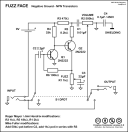In September/October last year, I built my second guitar out of
plywood. The body is a cuboid of size 30 cm x 20 cm x 10 cm.
Before glueing it together, I cut out two soundholes
(Dell'Arte Swing 1942 shape, see September 2007 below) and sanded it
with fine grit sandpaper. The neck is made of pinewood and the
fretboard is another piece of plywood glued on top of it and
sticking out across the body. Both the nut and the bridge where
also sawn out of plywood.
I replaced the headstock several
times (I was experimenting and had no clear design upfront) and
finally stuck with this rescaled Fender replica. It's made of
three layers of triplex (plywood) glued together.
The back of
the neck was sanded for hours with half a piece of plastic
pipe covered with sandpaper on the inside to get a rounded shape.
It goes right through the body and sticks out at the other end,
the same way traditional cigar box guitars were made.
The distance between the nut and the bridge turned out to be
79 cm which is quite long for a guitar. It's actually somewhere
between a normal guitar (~65 cm) and a bass guitar (~89 cm). To
avoid extremely high tension on the strings and neck, I wired it
up with nylon G-B-E strings, but tuned it to E-A-D instead
(sometimes D-A-D which gives a nice drone). That way, the lowest
string sounds like a normal D string on the second fret.
The red lacquer was applied with a brush. The fretboard, the nut
and the bridge were covered
with four layers of transparent wood stain, which seems to be
not that transparent after four layers :)
I used real fretwire (medium sized) for the frets and simple
stickers for the dots. All in all, it turned out quite nicely
and plays smoothly. Some things are clearly wrong (the neck is too
long, the headstock is too far away from the nut, et cetera) but
I have learned a lot along the way, so hopefully my next
experiment will turn out even better.
I did not take any photographs during the build stages, but I
made a few quick sketches afterwards in case somebody wants
to try build their own.










































